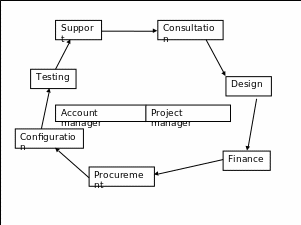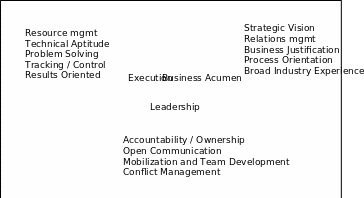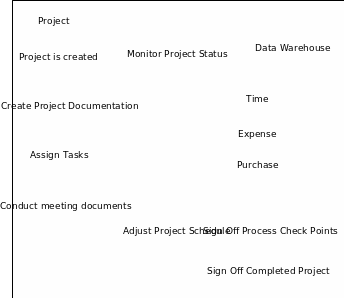Executive Summary
The aim of the project is the creation of the plan for hotel building. The plan will entail business objectives, approaches, and description of the plan and principles of its implementation. Budget and project control will be regarded as the key aspects of this report, and management principles will be analyzed from the perspective of successful time, quality, and resource management. The roles of the stakeholders will depend on their own aims and objectives; hence, their activity and interestedness in the success of this project will be regarded as the defining factor for their role in the plan.
Project Description
The scope of the industry is closely associated with accommodation, and the scope of the project requires the proper observation of all the aspects and terms, required for the comfortable accommodation. Thus, the scope of the project is aimed at creating the solid basis for the balanced resource, time and quality management. Scope will be regarded as the central aspect of project management strategy, and the values of hotel business global experience.
The business need is the creation of the hotel building plan for further hotel business development. The key aims of the project are closely associated with proper management of financial, operational, human and risk management. The basics of the scope are regarded as the outline of the functionality aspects, required for the proper project management. The need of the project creation was originated by the complexity of the project and the strong necessity to meet the requirements of the hotel business industry. Thus, the magnitude of the opportunity is represented by the necessity to create, adjust, and launch all the systems required for hotel activity.
The clear objectives of thee project help to define the aims, and formulate the plans of the project implementation. On the one hand, this is required for better motivation of employees, on the other hand, it provides an opportunity for performing the precise progress measurements.
In accordance with Baum (p. 45), the most effective business objectives in hotel industry are the following:
Specific – objectives are aimed at what the business does, e.g. a hotel might have an objective of filling 60% of its beds a night during October, an objective specific to that business. Measurable – the business can put a value to the objective, e.g. £ 25,000 in sales in the next half year of trading. Agreed by all those concerned in trying to achieve the objective. Realistic – the objective should be challenging, but it should also be able to be achieved by the resources available. Time specific – they have a time limit of when the objective should be achieved, e.g. by the end of the year (Baum, p. 45).
In the light of this fact, it should be emphasized that the actual aims of the project are explained by management strategy, with the applied efforts, associated with personnel training and professional development. Additionally, the company aims to arrange the reliable marketing strategy for further successful cooperation with recognized and trusted brands of hotel industry.
Reasons for Undertaking the Project
The reasons are closely associated with the necessity to expand the network of hotels, offering the high quality accommodation services. Additionally, the organization is intended to arrange the proper operation of the hotel properties for the stakeholders, and hopes for further reliable and fruitful cooperation. As for the quality of accommodation services, the company aims to create the UK 4 star level quality of the provided services, and maintain the level of these services. The company – performer of the project, aims to build reliable relations with the other investors, and create the sufficient contractual basis for the successful development of the hotel networking. Thus, the position of the company in the building and hotel industry will be re-established, and the company itself will be regarded as a recognized and reliable Hotel Management Company.
The business aims of the project entail the necessity to achieve the certain profit level, which will be sufficient for further reinvestment and provide the suitable returns to stakeholders. Hence, the company needs to achieve the suitable and optimal advertising strategy, aimed at improving the ethical standards in customer care strategy and relations with the suppliers.
Anticipated Benefits
The potential benefits of the project are closely associated with the enlisted objectives and reasons. In fact, the anticipated benefits of the project depend on the reliability of the partnership between the stakeholders and the company-performer. Additionally, the benefits of the completed project will be regarded from the perspective of the accommodation success and the satisfaction of the visitors. As for the accommodation principles, which should be implemented during the construction, these are as follows:
- The accommodation surrounding suits the aims and purposes of the visitors
- Selling, marketing and promotion strategies of the hotel services should correspond to the architectural appearance of the construction.
- Infrastructure, maintenance and security principles should be included into the initial project of hotel construction
In fact, the benefits of the project depend not only on the return levels, but also on the popularity of the hotel within tourists, thus, all the principles of accommodation should be implemented into the design and construction projects.
In fact, the construction project which considers the comfort level of the future visitors on the construction stage may become a project which could end up as a alternative approach towards accommodation and hospitality. Surely, when construction companies are financed by a particular group of stakeholders, the actual necessity of the construction is to create a reliable project, which will be within the frames of existing budget. However, the development of the project should be strictly observed for keeping it within the stated objectives. Additionally, the hotel industry players should value the alternative approaches.
In fact, the key benefit of the project will be explained by further growth of hospitality industry. Thus, the company will be able to enter the wider hotel-building market, as well as the construction market in general, and the cooperation with stakeholders will be more fruitful and trusted.
The accommodation market in general is regarded as very specific, and the actual necessity to meet the requirements of accommodation and hospitality rules provides an essential restriction for the development of alternative approaches. However, this specification provides a reliable justification of the project implementation. As Dunning and Sumit (p. 178) emphasized:
The land upon which they stand may be well developed, and near by property may not be available. If the owner of a single successful unit wishes to expand, he might do so not by increasing the size of existing accommodation facility, but by opening up new units in different areas. This also may occur because of takeovers and mergers. Such expansion is called horizontal integration – the growth of firms by the multiplication of similar units at the same level of production. In the hotel and catering industry most of this occurs at the retail level.
Initially, the growth aspects have been already discussed, however, it should be stated that the actual increase rate depends on the quality of the performed services, which essentially depend on the construction success, and meeting of the accommodation standards.
Start and Finish Points of the Project. Deliverables
The starting point of the project entails all the necessary preparations, associated with the project elaboration, design planning, and development of the reliable and trusted cooperation with clients (stakeholders). The beginning of project implementation should be started from the studying of the clients’ interests, and thinking over the tools of their consideration in the plan. The details of the plan should be discussed with the clients, as they might wish to control the process. The timetable (approximate) of on-site meetings and briefings should be given in advance. The next step is the verification of the quality, safety, and health standards. These should correspond to the commonly accepted norms.
The final point of the project is the constructed hotel, built in accordance with the commonly accepted standards, and four-star level quality of the services. The deliverables of the project generally entail both included and excluded services. The new services of the project involve the providing of the high quality accommodation services, aimed for tourists and residents. The key aim of these services is to fill market of accommodation and hospitality services, and the aims of the company is to gain the reputation of the reliable partner in the sphere of construction. The feasibility of these objectives depends on the rules and principles of project performance. In fact, the feasibility of the project should be regarded as the traditional perspective of successful implementation of the project objectives. The new system maintenance should be arranged as a result. This system involves the hospitality and accommodation services, which are the key principles of hotel business success.
Risks and Constraints
In fact, the hotel business is subjected to numerous risks, and the aspects and sides of possible restraints are closely associated both with technological and human factors. Insurance is only a part of the solution, as the best protection from risks is the talented risk management, as a large number of hotels were unable to recover in spite of the adequate insurance compensation. The risk factors may be of natural, financial, or business character. The natural factors are:
- Arson
- Electrical installations
- Fire protection
- House keeping
- Security and Intruder Alarms
- Health and Safety
- Hot Work and Control of Contractors
- Water damage
Financial are as follows:
- Bankruptcy of the stakeholders
- Inflation of the currency
- Unexpected changes of the prices on realty market
- Illegal raider capturing of a territory
Business factors entail the reasons of the financial factors, and the consequences of natural disasters. In fact, competitors may arrange arson, or win one of the project managers over. Thus, the risks will depend on the current market situation, economic environment and attitude of other competitors towards the company. The key aim of this part is to provide the adequate disaster recovery measures. However, adequate and thorough risk management principles should be implemented. The key aspects of risk management are as follows: first, responsibilities and activities should be defined (who and what should do in the case of risky situation). The locations of the necessary items and things should be available, and known for all the workers responsible for disaster recovering. The identification and communication system should be prepared beforehand, and maintained workable.
Activity List
In fact, the project should be described by the company, basing on clients’ wishes and recommendations. Otherwise, the dead ends are inevitable. Thus, as Sebestyén (p. 381) emphasizes:
Clients often describe projects in terms of the types of capacity building activities in the project, rather than of the overall nature of the project. For example, they might refer to the project as “fundraising” or “strategic planning,” rather than “resource development” or “setting the long-term direction for the organization. Clients often hire consultants based on how closely the consultant’s services match what the client believes the activities should be.
Event Analysis
Events of the project implementation phase are closely associated with the aspects of project management, which are regarded from the perspective of irregular customers’ behavior (Howes, p. 56). In general the actual flow of events will by cycled:

The entire management of the project is divided into three main components:

Finally, the events of the project implementation will be associated with project management, considering the principles of strict division into preparation and resource management approaches. Thus, the theoretical part will be united into single “Project” block, while the resource management will be controlled by the block’s regulations.

Resource Allocation
The allocation of the resources, required for the implementation of the described project is closely associated with the requirements of hotel industry and construction design. Thus, considering the necessity to implement the balanced project, centralized, balanced resource allocation approach will be required (Frame, p. 67). On the one hand it will slower the implementation process, on the other hand, it is one of the risk management and prevention means. Thus, the allocation plan should be developed by the centralized border, and with the consideration of hotel industry processes. In accordance with Howes (p. 254):
All entities send messages requesting resources and the allocator responds with the allocated resources. The main advantage of this scheme is simplicity. However, the disadvantage is that as the system size increases, the centralized allocator gets heavily loaded and becomes a bottleneck.
Nevertheless, considering the time scope of the project, and the opportunity to allocate the assignments and resources, the likelihood of bottleneck is close to zero.
Conclusion
Hotel building, jointly with accommodation industry is a specific sphere, which requires particular approaches and accurate project planning. The elaboration of the hotel building project is based on the principles of risk management analysis, required for the successful construction of four-star hotel. The project management strategies were selected from the perspective of industry specifications, and the factors of further cooperation of the performer with other stakeholders and hotel industry representatives.
Works Cited
- Baum, Joel A. C. “The Changing Basis of Competition in Organizational Populations: Hotel Industry.” Social Forces 74.1 (2005): 177-204.
- Dunning, John H., and Sumit K. Kundu. “The Internationalization of the Hotel Industry – Some Findings from a Field Study.” Management International Review 35.2 (2007): 101
- Frame, J. Davidson. The New Project Management: Tools for an Age of Rapid Change, Complexity, and Other Business Realities. San Francisco: Jossey-Bass, 2005.
- Howes, Norman R. Modern Project Management: Successfully Integrating Project Management Knowledge Areas and Processes. New York: AMACOM, 2007.
- Sebestyén, Gyula. Construction: Craft to Industry. London: E and FN Spon, 2008.